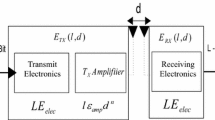Abstract
Sensor networks comprise of sensor nodes with limited battery power that are deployed at different geographical locations to monitor physical events. Information gathering is a typical but an important operation in many applications of wireless sensor networks (WSNs). It is necessary to operate the sensor network for longer period of time in an energy efficient manner for gathering information. One of the popular WSN protocol, named low energy adaptive clustering hierarchy (LEACH) and its variants, aim to prolong the network lifetime using energy efficient clustering approach. These protocols increase the network lifetime at the expense of reduced stability period (the time span before the first node dies). The reduction in stability period is because of the high energy variance of nodes. Stability period is an essential aspect to preserve coverage properties of the network. Higher is the stability period, more reliable is the network. Higher energy variance of nodes leads to load unbalancing among nodes and therefore lowers the stability period. Hence, it is perpetually attractive to design clustering algorithms that provides higher stability, lower energy variance and are energy efficient. In this paper to overcome the shortcomings of existing clustering protocols, a protocol named stable energy efficient clustering protocol is proposed. It balances the load among nodes using energy-aware heuristics and hence ensures higher stability period. The results demonstrate that the proposed protocol significantly outperforms LEACH and its variants in terms of energy variance and stability period.

















Similar content being viewed by others
References
Afsar, M. M., & Tayarani-N, M. (2014). Clustering in sensor networks: A literature survey. Journal of Network and Computer Applications, 46, 198–226.
Pantazis, N. A., Nikolidakis, S. A., & Vergados, D. D. (2013). Energy-efficient routing protocols in wireless sensor networks: A survey. IEEE Communications, Surveys & Tutorials, 15(2), 551–591.
Memon, I., Jamro, D. A., Mangi, F. A., Basit, M. A., & Memon, M. H. (2013). Source localization wireless sensor network using time difference of arrivals (TDOA). International Journal of Scientific & Engineering Research, 4(7), 1046.
Memon, I., Hussain, I., Akhtar, R., & Chen, G. (2015). Enhanced privacy and authentication: An efficient and secure anonymous communication for location based service using asymmetric cryptography scheme. Wireless Personal Communications, 84, 1487–1508.
Memon, I. (2015). A secure and efficient communication scheme with authenticated key establishment protocol for road networks. Wireless Personal Communications, 85, 1167–1191. doi:10.1007/s11277-015-2833-0.
Heinzelman, W. B., Chandrakasan, A., & Balakrishnan, H. (2000). Energy-efficient communication protocol for wireless microsensor networks. In Proceedings of the 33rd Annual Hawaii international conference on system siences (HICSS-33) (p. 223), IEEE. doi:10.1109/HICSS.2000.926982.
Smaragdakis, G., Matta, I., & Bestavros, A. (2004). SEP: A stable election protocol for clustered heterogeneous wireless sensor networks. In Proceedings of the international workshop on SANPA. http://open.bu.edu/xmlui/bitstream/handle/2144/1548/2004-022-sep.pdf?sequence=1.
Kumar, D., Aseri, T. C., & Patel, R. B. (2009). EEHC: Energy efficient heterogeneous clustered scheme for wireless sensor networks. Computer Communications, 32, 662–667.
Tyagi, S., & Kumar, N. (2013). A systematic review on clustering and routing techniques based upon LEACH protocol for wireless sensor networks. Journal of Network and Computer Applications, 36(2), 623–645.
Kumar, D. (2014). Performance analysis of energy efficient clustering protocols for maximising lifetime of wireless sensor networks. IET Wireless Sensor Systems, 4(1), 9–16.
Kang, S. H., & Nguyen, T. (2012). Distance based thresholds for cluster head selection in wireless sensor networks. IEEE Communications Letters, 16(9), 1396–1399.
Tarhani, M., Kavian, Y. S., & Siavoshi, S. (2014). SEECH: Scalable energy efficient clustering hierarchy protocol in wireless sensor networks. IEEE Sensors Journal, 14(11), 3944–3954.
Mahajan, S., Malhotra, J., & Sharma, S. (2014). An energy balanced QoS based cluster head selection strategy for WSN. Egyptian Informatics Journal, 15, 189–199.
Aderohunmu, F. A., Deng, J. D., & Purvis, M. K. (2011). A deterministic energy-efficient clustering protocol for wireless sensor networks. In Proceedings of the 7th international conference on intelligent sensors, sensor networks and information processing (ISSNIP ‘11) (pp. 341–346), IEEE. doi:10.1109/ISSNIP.2011.6146592.
Manjeshwar, A., & Agrawal, D. P. (2001). TEEN: A routing protocol for enhanced efficiency in wireless sensor networks. In Proceedings of international parallel and distributed processing symposium (IPDPS’01) workshops (pp. 2009–2015), San Francisco, CA, USA. doi:10.1109/IPDPS.2001.925197.
Kashaf, A., Javaid, N., Khan, Z.A., & Khan, I.A. (December, 2012). TSEP: Threshold-sensitive stable election protocol for WSNs. In Proceedings of 10th international conference on frontiers of information technology (pp. 164–168), IEEE, Islamabad.
Mittal, N., & Singh, U. (2015). Distance-based residual energy-efficient stable election protocol for WSNs. Arabian Journal for Science and Engineering, 40, 1637–1646.
Amini, N., Vahdatpour, A., Xu, W., Gerla, M., & Sarrafzadeh, M. (2012). Cluster size optimization in sensor networks with decentralized cluster-based protocols. Computer Communications, 35, 207–220.
Rappaport, T. (1996). Wireless communications: Principles & practice. Englewood Cliffs, NJ: Prentice-Hall.
Karl, H., & Willig, A. (2005). Protocols and architectures for wireless sensor networks. Hoboken: Wiley.
Author information
Authors and Affiliations
Corresponding author
Rights and permissions
About this article
Cite this article
Mittal, N., Singh, U. & Sohi, B.S. A stable energy efficient clustering protocol for wireless sensor networks. Wireless Netw 23, 1809–1821 (2017). https://doi.org/10.1007/s11276-016-1255-6
Published:
Issue Date:
DOI: https://doi.org/10.1007/s11276-016-1255-6




